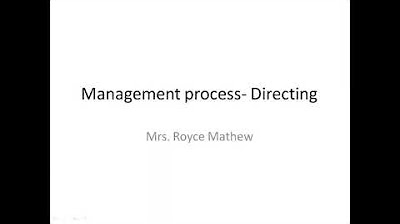HR Basics: Succession Planning
Summary
TLDRSuccession planning is a crucial HR strategy that identifies and develops high-potential employees for future leadership roles, ensuring organizational continuity. This process involves assessing key positions, understanding long-term goals, and evaluating workforce trends. A structured five-step model—identify key positions, assess high performers, prepare participants, offer developmental opportunities, and monitor progress—helps organizations avoid costly vacancies. The use of tools like the nine-box grid and employee self-assessments supports targeted talent development. Regular reviews and strategic alignment ensure that succession planning remains effective and adaptable to business changes.
Takeaways
- 😀 Succession planning is the process of identifying, evaluating, and developing high-potential employees for future leadership roles.
- 😀 It helps organizations prepare for both expected and unexpected absences in key positions to maintain stability in business operations.
- 😀 Succession planning should be a priority for employers and integrated into the organization's strategic business plan.
- 😀 It provides developmental opportunities for employees at all levels and helps create a more diverse workforce.
- 😀 A five-step succession planning process typically includes identifying key positions, identifying high performers, preparing participants, providing developmental opportunities, and monitoring progress.
- 😀 Regularly assessing critical positions and competencies ensures that an organization is ready to fill key roles and prevent costly vacancies.
- 😀 Organizations should focus on long-term succession planning, identifying not only employees ready now but those who might be ready in 3-5 years.
- 😀 The nine-box grid is a widely used tool for evaluating employee potential and identifying future leaders based on current performance and potential.
- 😀 Employee self-assessment can play an important role in the succession planning process by facilitating productive conversations and identifying skill gaps.
- 😀 Monitoring and closing skill gaps over time is a critical component of ensuring the success of a succession plan, requiring ongoing effort and attention.
- 😀 Succession planning must be aligned with overall workforce planning and strategic human resource management efforts to effectively address the organization's future needs.
Q & A
What is the primary goal of succession planning?
-The primary goal of succession planning is to identify high-potential employees, evaluate their skills, and prepare them for advancement, ensuring that key positions in an organization are filled to maintain business stability.
Why do employers often avoid succession planning?
-Employers often avoid succession planning or engage in it informally because it is seen as a complex, long-term task that requires careful consideration of both foreseeable and unforeseen absences of key roles, which can be difficult to plan for in advance.
What are the five basic steps in most succession planning models?
-The five basic steps in most succession planning models are: identifying key positions, identifying high performers, preparing participants, providing developmental opportunities, and monitoring progress.
How does succession planning contribute to workforce diversity?
-Succession planning contributes to workforce diversity by enabling decision-makers to look at the future makeup of the organization and ensuring that a diverse group of employees is considered for leadership roles and development opportunities.
What is the role of performance metrics in succession planning?
-Performance metrics play a crucial role in succession planning by helping to identify critical employees and assess their contributions, skills, and readiness for future leadership roles, allowing for a more strategic approach to talent management.
What is the nine-box grid, and how is it used in succession planning?
-The nine-box grid is a commonly used tool in succession planning to evaluate an organization's current talent. It assesses employees' current performance, potential for growth, and level of contribution, helping to identify high-potential candidates for future leadership roles.
How can employee self-assessments contribute to succession planning?
-Employee self-assessments contribute to succession planning by providing valuable insights into an employee's own perspective on their skills, strengths, and development areas. This fosters productive conversations and helps identify potential gaps that need to be addressed.
Why is it important to think beyond immediate succession and consider future leadership candidates?
-It is important to consider potential future leaders (3-5 years ahead) to ensure a long-term talent pool, avoid depriving the organization of future leadership candidates, and address future challenges with well-prepared talent.
What challenges might organizations face in succession planning?
-Organizations might face challenges such as operational pressures, unexpected organizational changes, and the difficulty of predicting future talent needs, all of which can disrupt the succession planning process. Maintaining focus and continuously reviewing the plan is key to overcoming these challenges.
How should succession planning be integrated into an organization’s overall strategy?
-Succession planning should be integrated into the organization's strategic business plan by aligning it with long-term goals, ensuring that key positions are filled with qualified candidates, and regularly reviewing and adjusting the plan to reflect changing business needs and workforce trends.
Outlines

This section is available to paid users only. Please upgrade to access this part.
Upgrade NowMindmap

This section is available to paid users only. Please upgrade to access this part.
Upgrade NowKeywords

This section is available to paid users only. Please upgrade to access this part.
Upgrade NowHighlights

This section is available to paid users only. Please upgrade to access this part.
Upgrade NowTranscripts

This section is available to paid users only. Please upgrade to access this part.
Upgrade NowBrowse More Related Video

Why Succession Planning is essential: The Case of the Runaway Talent

Ten Best Practice HR Tips - Human Rescource Best Practise | MeetTheBoss

Manajemen Talenta ASN #2

Ten Best Practice HR Tips - Human Rescource Best Practise | MeetTheBoss

SAP SuccessFactors Succession Planning

Management Process- Directing
5.0 / 5 (0 votes)